Budgeting Smarter: How To Scale Paid Ad Campaigns Without Throwing Money Away
1. Introduction: The Cost of Thoughtless Ad Expenditure – Why Most Brands Waste Money Pointlessly
Scaling successful paid ad campaigns successfully involves precision, strategy, and data-driven decision-making—yet most brands kill themselves by scaling budgets blind, wasting ad spend, and seeing diminishing returns. The brutal truth? More money doesn't translate to more revenue if campaigns are not set up right from the beginning.
Why Do Most Brands Waste Money When Scaling Paid Ads?
- Premature Scaling: Scaling up the budget before confirming creatives, audience targeting, and funnel alignment results in increased CPAs and reduced ROAS.
- Misaligned Funnel Spending: Executing bottom-funnel conversion ads at the awareness stage (or vice versa) causes ineffective engagement and wasted impressions.
- Over-Reliance on Vanity Metrics: Prioritizing likes, clicks, or impressions over actionable KPIs such as ROAS, CAC, and customer lifetime value (LTV).
- Overlooking the Learning Phase: Sudden budget spikes interfere with Meta and Google's algorithm optimization, pushing campaigns into the chaotic learning phase.
The Shift from Guesswork to Strategic Budget Allocation
Rather than throwing money at struggling campaigns, top marketers take a systematic, phased approach:
- Audit Current Campaigns – Find top performers and zero out wasteful budgets.
- Synch Budgets with Funnel Stages – Assign spend according to where users are in the process.
- Scale Gradually – Budget increases in managed steps (20-30% increments).
- Leverage Automation & AI – Utilize intelligent bidding and AI-powered optimizations to optimize efficiency.
Key Takeaway: Scaling is not a matter of spending more–it's about spending smarter.
2. Know Your Funnel First: Awareness, Consideration, Conversion – Strategic Ad Spend Blueprint
Paid ads perform drastically differently at each stage of the buyer’s journey. Mismatching ad intent with funnel stages is the #1 reason campaigns fail.
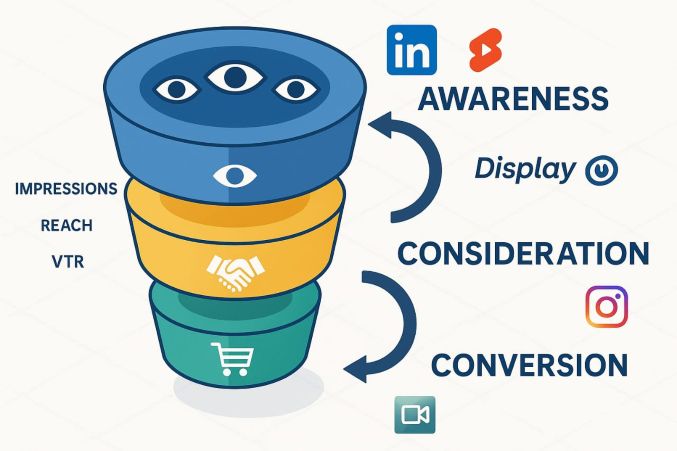
Breaking Down the Three Critical Funnel Stages
|
Stage |
User Mindset |
Ad Goal |
Key Metrics |
Best Ad Types |
|
Awareness |
"I have a problem." |
Introduce brand, educate |
CPM, VTR, Reach |
Video ads, reach campaigns |
|
Consideration |
"I’m exploring solutions." |
Build trust, nurture leads |
CTR, CPL, Engagement Rate |
Retargeting, lead magnets |
|
Conversion |
"I’m ready to buy." |
Drive sales, sign-ups |
ROAS, CPA, Conversion Rate |
Performance Max, search ads |
Why Most Ads Fail – And How to Fix Them
❌ Running Conversion Ads on Cold Audiences → High costs, low conversions.
✅ Fix: Warm up cold traffic with awareness content before retargeting.
❌ Using Broad Targeting in Bottom-Funnel Campaigns → Wasted spend on uninterested users.
✅ Fix: Use lookalike audiences and retargeting for higher intent.
❌ Ignoring Frequency & Ad Fatigue → Rising CPMs, declining engagement.
✅ Remedy: Monitor frequency (optimal: 3-5x/user) and rotate creatives frequently.
Pro Tip:
- Track your ad creatives against funnel steps (i.e., tutorial videos for awareness, testaments for consideration, urgent CTAs for conversion).
- Filter out previous buyers from prospecting campaigns to prevent wasted spend.
3. Budgeting for Awareness: Buy Attention, Not Clicks – The Art of Top-Funnel Dominance
Awareness campaigns aren't about instant sales—they're about sowing seeds for future conversions.
How Much to Spend on Awareness?
- 20-30% of overall ad budget (40-50% if you're a new brand).
- Objective: Optimize reach, not direct conversion.
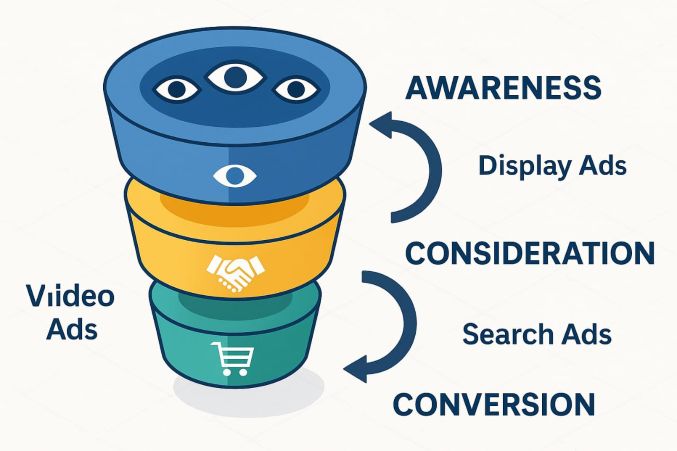
Most Suitable Platforms & Ad Forms for Awareness
✔ Meta (Facebook/Instagram):
- Reach & Frequency Campaigns (controlled impressions).
- Video Ads (6-15 sec hooks for maximum retention).
- Carousel Ads (displaying several products/features).
✔ YouTube & TikTok:
- Skippable In-Stream Ads (5-sec rule: grab attention quickly).
- Story Ads (full-screen, engaging experiences).
✔ Programmatic & Display Ads:
- Wide reach with lower engagement (ideal for retargeting later).
CPM-Focused Strategy – Why Paying for Impressions Trumps Chasing Clicks
- Awareness = Attention. Optimize for low CPM, high VTR (View-Through Rate).
- Benchmarks:
- CPM: $5-$15 (depending on the niche).
- VTR (Video Ads): > 20% (a sign of high engagement).
Pro Scaling Tactics:
- Apply broad interest targeting (tactically avoid narrow groups at this juncture).
- Retarget interested users (10-sec+ video viewers, page engagers) in consideration phase.
4. Budgeting for Consideration: Educate, Engage, Retarget – Converting Warm Leads to Buyers
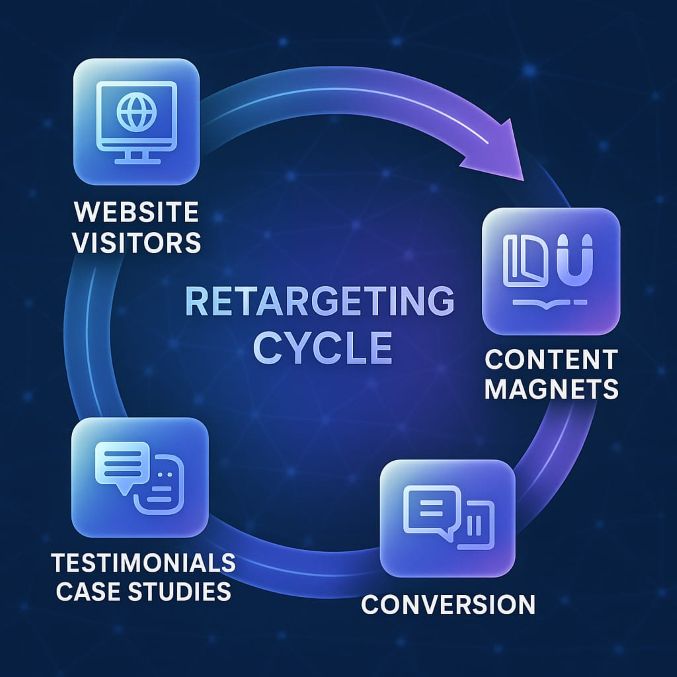
Now that users know your brand, engage them with high-value content that instills confidence.
Budget Allocation for Consideration
- 30-40% of overall budget.
- Retailer interest in retargeting (site visitors, engaged users, email lists).
Best Ad Types for Consideration
✔ Retargeting Ads:
- Dynamic Product Ads (display viewed products).
- Catalog Sales (upsell/cross-sell opportunities).
✔ Lead Magnets:
- Free trials, eBooks, webinars (value in exchange for contact information).
✔ Social Proof & Trust Builders:
- Case studies, testimonials, demo videos.
KPIs That Matter in the Consideration Stage
- CPL (Cost Per Lead):
- < $20 (B2C) or < $50 (B2B).
- CTR (Click-Through Rate):
- 2% (better than awareness campaigns).
- Engagement Rate:
- Comments, shares, saves signal high intent.
Pro Tip:
- Use lead forms (Facebook Instant Forms, LinkedIn Lead Gen) to collect emails effectively.
- Exclude repeat purchasers to prevent wasted spend.
5. Budgeting for Conversion: Invest Where ROI Lives – Maximizing Profitable Scaling
This is where you drive revenue—target high-intent users who are ready to buy.
Budget Allocation for Conversion
- 40-50% of budget (highest priority for scaling).
- Tackle proven audiences (lookalikes, remarketing, branded search).
Best Ad Types for Conversions
✔ Performance Max (Google) / Advantage+ (Meta):
- AI-optimized for conversions on networks.
✔ Search Ads (Google/Bing):
- High-intent keywords ("buy [product]").
✔ Dynamic Retargeting:
- Display abandoned cart products with urgency messaging.
Scaling Strategies for High-ROAS Campaigns
- Lookalike Audiences (LAL):
- Begin with 1-3% LAL of best customers.
- Remarketing:
- 30-day site visitors, cart abandoners.
- Branded Search Ads:
- Prevent competitors from bidding on your brand.
Testing & Optimization for Maximum Efficiency
- CBO (Campaign Budget Optimization) vs. ABO (Ad Set Budgeting):
- CBO: Let Meta/Google dynamically allocate budget (best for scaling).
- ABO: Manual control (best for testing).
- Bid Strategies:
- MAX Conversions (for volume).
- Target ROAS (for efficiency).
Pro Scaling Rule:
- Never raise budgets by 20-30% or more at once—prevents learning phase resets.
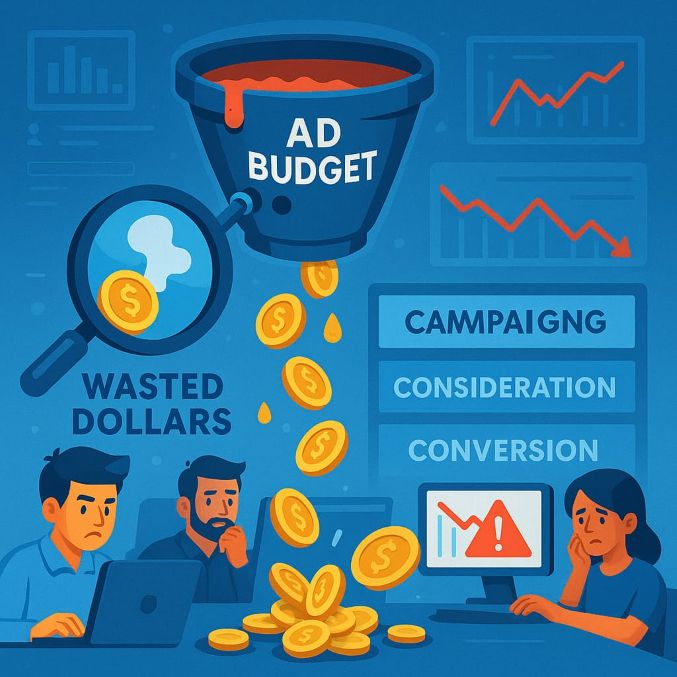
6. The 70-20-10 Rule: A Time-Proven Budget Allocation Strategy for Sustainable Growth
Scaling paid ads is not laying all your bet on red—it's balancing risk vs. reward with smart budget allocation. The 70-20-10 rule is a tried-and-tested strategy employed by high-performing brands to scale effectively.
Why This Rule Works
Most brands struggle with scaling because they either:
- Play it too safe (scaling only what's already working, losing out on new opportunities)
- Be irresponsible with risks (overspending on untested approaches that deplete budgets)
The 70-20-10 approach erases guesswork by organizing spend for stability, optimization, and innovation.
Segmenting the 70-20-10 Budget Allocation
|
Budget Segment |
Allocation |
Purpose |
Where to Invest |
|
70% - Proven Winners |
70% of budget |
Scale proven high-ROAS campaigns |
Lookalike audiences, retargeting, branded search |
|
20% - Optimization |
20% of budget |
Test winning campaign improvements |
New creatives, ad copy optimizations, landing page tests |
|
10% - Experimentation |
10% of budget |
Discover new opportunities |
New platforms, new ad formats, untapped audiences |
How to Apply the 70-20-10 Rule
✔ 70% on Winning Campaigns → Double down on what's already working.
✔ 20% on Optimization → A/B test creatives, audiences, and placements.
✔ 10% on Experimentation → Test one new variable at a time (e.g., TikTok ads, connected TV).
Pro Tip:
- Reallocate budget month-to-month—if an experiment campaign succeeds, transfer it into the 70% bucket.
- Never reduce optimization budgets—even winning campaigns require ongoing refinement.
7. Scaling Wisely: Horizontal vs. Vertical Budget Scaling – Which One Do You Need?
All scaling is not created equal. Vertical scaling (budget increase) and horizontal scaling (reach increase) impact performance very differently.
Key Differences Between Horizontal & Vertical Scaling
|
Factor |
Vertical Scaling |
Horizontal Scaling |
|
Definition |
Increasing budget on current campaigns |
Expanding to new platforms/audiences |
|
Best For |
Maximizing ROAS from proven audiences |
Finding new high-intent customer segments |
|
Risk Level |
Lower risk (if incrementally done) |
Higher risk (untested variables) |
|
When to Use |
When CPA is stable & ROAS is strong |
When existing audiences are saturated |
How to Scale Vertically Without Breaking Performance
- Take budgets up in 20-30% increases (doesn't reset learning phases).
- Use CBO (Campaign Budget Optimization) to allow algorithms to spend efficiently.
- Track frequency caps (if frequency is over 5-7x, rotate creatives).
When to Scale Horizontally (And How to Do It Safely)
✅ New Lookalike Audiences (scale from 1% to 3-5% LAL).
✅ New Channels (e.g., introducing Pinterest or LinkedIn if demographics are a match).
✅ New Ad Units (trying Reels ads if static pics are fatigued).
Pro Tip:
- Always horizontally test with the 10% experimentation budget prior to going all in.
- Use exclusion audiences to avoid overlap between new and old campaigns.
8. Metrics to Monitor While Scaling – The Early Warning Signs of Overspending
Blindly scaling without monitoring the correct metrics is like driving a car with your eyes closed. These KPIs inform you when to go forward or pull back.
The 5 Scaling Metrics You Must Watch
- Customer Acquisition Cost (CAC):
- Ideal: CAC < 30% of customer lifetime value (LTV).
- Danger Zone: If CAC increases >50% of LTV, scaling is not sustainable.
- Return on Ad Spend (ROAS):
- Healthy: 3x+ ROAS for e-commerce, 5x+ for high-ticket offerings.
- Warning Sign: ROAS drops below 2x—re-evaluate targeting or creatives.
- Frequency:
- Sweet Spot: 3-5 impressions per user (awareness), 5-7 (retargeting).
- Ad Fatigue Alert: Frequency >7 means you’re oversaturating audiences.
- Quality Score (Google Ads) / Relevance Score (Meta):
- Good: 8-10 (indicates high ad engagement).
- Poor: Below 6—time to refresh ad copy or targeting.
- Click-Through Rate (CTR):
- Benchmarks:
- Awareness: 1-2%
- Consideration: 2-3%
- Conversion: 3-5%
- Red Flag: CTR drops >20%—sign of creative fatigue.
- Benchmarks:
How to React to Metric Alerts
- Increasing CAC? Tighten up audiences, optimize landing pages.
- Decreasing ROAS? Stop underperforming ad sets, try new creatives.
- High Frequency? Ad creative rotation or scaling up audiences.
9. Ad Budgeting Tools and Tech for Smarter Ad Spending – Streamlining Efficiency
Manual ad budgeting is time-consuming and error-prone. These tools optimize spend at scale.
Must-Have Ad Budgeting Tools
- Meta's Advantage+ Suite:
- Advantage+ Shopping: AI-powered campaign optimization.
- Advantage+ Audience: Auto-extends high-intent audiences.
- When to Trust It: For wide targeting, not niche audiences.
- Google's Smart Bidding:
- Target ROAS / tCPA: Automatically bids for conversions.
- When to Ignore It: If you have low conversion volumes (<50/month).
- Automated Rules (Meta/Google Ads):
- Examples:
- "Pause ad sets if ROAS < 2x for 3 days."
- "Increase budget by 15% if CPA is below $30."
- Examples:
- Third-Party Budget Managers:
- Revealbot: Meta, Google, and TikTok automated rules.
- Optmyzr: AI-driven budget readjustment.
Pro Tip:
- Never count entirely on automation—always maintain manual oversight.
- Utilize UTM parameters to measure cross-channel performance within Google Analytics.
10. Conclusion: Spend Strategically, Scale Sustainably – The Long-Game Mindset
Scaling profitable paid ads isn't a dash—it's a marathon. The winners are:
✅ Budget allocate based on funnel stage (not instincts).
✅ Utilize the 70-20-10 rule (balance scaling, optimizing, experimenting).
✅ Scale vertically before expanding horizontally (avoid spreading budgets too thin).
✅ Track the right metrics (CAC, ROAS, frequency) to catch issues early.
✅ Leverage automation (but keep human oversight).
Final Pro Tips for Disciplined Scaling
- Document everything—winning audiences, creatives, budgets.
- Reinvest profits—don’t scale faster than your cash flow allows.
- Stay patient—sometimes the algorithm needs 7-14 days to optimize.
What’s your #1 scaling challenge? Comment below—we’ll help solve it!

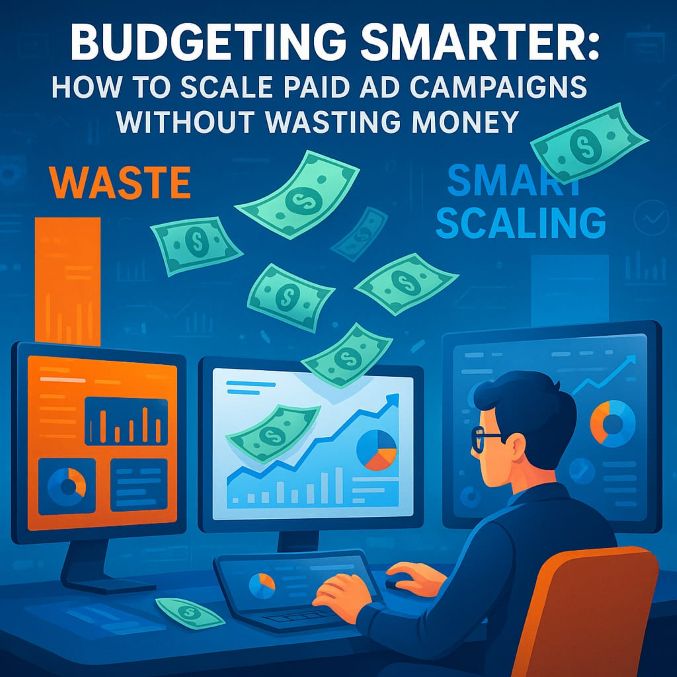
Comments
No Comments To Display